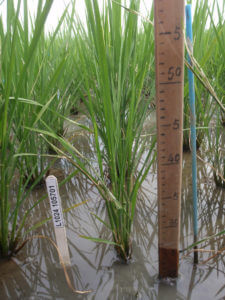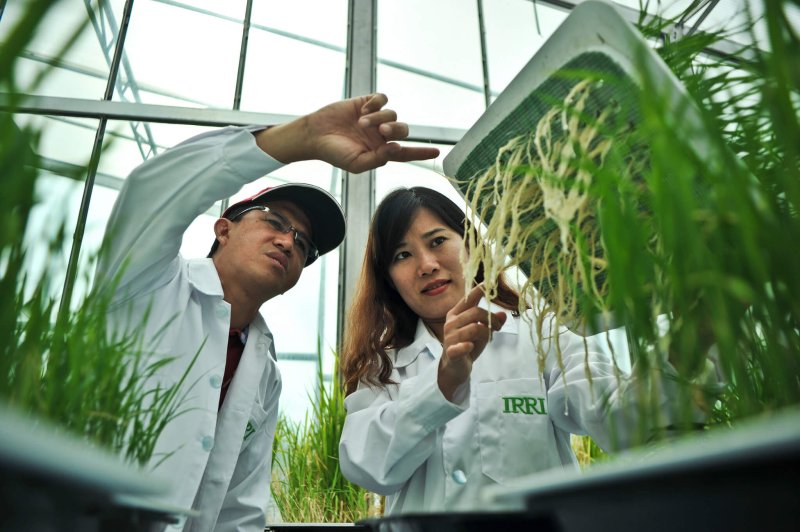Globally, humanity has reached “peak food,” according to a recent study by Ecology and Society. Peak rice was back in 1988, causing some worry about the long-term food security of this global staple crop. Peak chicken was in 2006. Peak milk and wheat were in 2004.
“People often talk of substitution. If we run out of one substance we just substitute another. But if multiple resources are running out, we’ve got a problem. Mankind needs to accept that renewable raw materials are reaching their yield limits worldwide,” said Jianguo “Jack” Liu, of Michigan State University.
Is it really as apocalyptic as it seems?
No, according to Hank Campbell, the founder of science communication site Science 2.0. While projecting increases in population, the model Liu and his colleagues used leaves food technology as static. Campbell wrote that the key to avoiding such a catastrophe is in embracing food science innovations:
Since the 1970s American farmers, who embrace science more than any in the world, have grown more food on less land in a way 1970s projections believed was only science-fiction. If Europe and the developing world embraced science the way American agriculture does, not only could we grow the same food we have right now, we could let farmland equivalent to the entire region of Amazonia go back to nature and not lose a single carrot.
As an example of food technology’s ability to address leveled yields, in December researchers were able to engineer rice genes to carry out a basic supercharged photosynthesis process and increase productivity. Many supporters of genetic engineering note that for some crops the technology increases yields, often with less input and while using less acreage. Anti-GMO activists vociferously dispute that.
There are two issues in play here: Do GM crops increase yield? And if they do, is this yield increase even necessary considering how much food goes to waste.
In a 2009 polemic, Doug-Durian Sherman, then with the Union of Concerned Scientists, wrote “Failure to Yield” in which he argued that yield improvements over the previous 25 years were the result of conventional breeding or farming practices, not GMOs. Specifically herbicide-resistant corn and soy have not had improved yields, while insect-resistant corn has slightly improved.
A USDA report last year supports that position in part. It indicates that yields in the US increased only slightly over the first 15 years of the commercialization of GMO crops. The advantage for farmers, it said is in saving on insecticide due to using insect-resistant crops. However, surveys in the developing world, home to more than half of the farms using GM crops, yields have increased as much as 40 percent, in part because of improved efficiencies.
But does the world need more crops and food? The popular view propagated on anti-GMO websites and even in the left media which is dogmatically critical for the technology is “no.” The far left Nation framed the issue in polarized terms in its essay, “Can GMOs Help Feed a Hot and Hungry World?”
The high cost of GMO field-testing may explain why the only genetically modified crops that have made it to market are, in the words of environmental scientist Jonathan Foley, “very disappointing” and “come with some big problems.”
“GMO efforts may have started off with good intentions to improve food security,” Foley wrote in a column in the science magazine Ensia in February, “but they ended up in crops that were better at improving profits.”
Strong opponents of genetic modification claim that independent of the issue of safety, the world just doesn’t need more crops—just better distribution. For example, GM Education, a website supported by Citizens Concerned about GM which claims, disingenuously, that it is not opposed to genetic engineering, writes that it’s too simplistic to promote increases in food production as a way to feed the world. It claims that the media that media inappropriately promotes GMO technology rather than focusing on the “real” problem: not supply but distribution:
The biggest problem with global malnutrition is politics. Distribution and supply, skewed wealth and corrupt governments are doing more harm to the starving masses than conventional food production ever will. There is plenty of food, enough produced globally even now, for nine billion people. We just need to tackle the more complicated political issues.
This is a familiar meme in the anti-GMO press, which claims that genetic modification is a danger-riddled technology that is just not necessary. Unfortunately, there is no magic bullet to rework the global food distribution system. The challenges of waste and what some consider “unfair” apportionment of food can be addressed, but only slowly and over decades. Meanwhile, the global population is soaring, and people are becoming more affluent in the developing world, sharply increasing the demand for food. Demanding reforms in food distribution doesn’t feed the hungry; increasing food production in hard-pressed countries would.
Even Gurian-Sherman, who now works with the anti-GMO Center for Food Safety, agrees that current yields will not meet growing demand; we need to increase yield—one way or another. “If we are going to make headway in combating hunger due to overpopulation and climate change, we will need to increase crop yields.” He just disagrees on how. “Traditional breeding outperforms genetic engineering hands down,” he’s said.
Therefore, raising yields remains a part of the work of the global development research, yet studying the best policy environment in which to release new technology has also become a priority. In the case of poor farmers, while researchers at the International Rice Research Institute work on genetically engineering a supercharged photosynthesis in rice could help raise yields, colleagues at the International Food Policy Research Institute (IFPRI) consider what supportive policy is needed.

Policy is so important, in fact, that the 2014 IFPRI report on global hunger doesn’t mention agricultural yield increases in its recommendation and instead focuses on policy priorities for governments. However, it does point out the importance of government support and incentives for scientists to develop nutritious seeds.
The point, however, is that this is a shift in thinking. Nathaneal Johnson, a food writer at Grist, asked Shenggen Fan, the director of the IRPRI, if there had been a change: “Yes,” he said. “It’s a sea change.”
The IFPRI is a part of the Consortium of International Agricultural Research Centers, known as CGIAR. The consortium is an independent international organization that got its start during the Green Revolution, which pushed agricultural innovations like hybridized seeds, pesticides and fertilizer as solutions to hunger.
Fan said that CGIAR used to be focused on yields, but in 2010, it made some reforms.
However, this isn’t necessarily a split from the past, and its website explains, “Our belief in science as a way to find humanitarian solutions has never wavered though and is as strong as ever.”
Fan still credits the role of science in the Green Revolution with preventing famine, but his message is clear: Policy plays a key role in guiding and ensuring innovations have impact.
The International Rice Research Institute (IRRI)—also one of the CGIAR centers—has been leading the work on supercharged photosynthesis, one innovation that is a potential tool in the larger toolbox of poverty solutions.

The researchers altered the genes in rice to show that C4 photosynthesis could work in rice.
“It’s the first time we’ve seen evidence of the C4 cycle in rice, so it’s very exciting,” said Thomas Brutnell, a researcher at the Danforth Plant Science Center in St. Louis.
C4 photosynthesis helps plants grow more efficiently by capturing carbon dioxide and fixing it in cells in the leaves. It is what makes corn and sugarcane so productive. Researchers said that it could boost rice and wheat yields by roughly 50 percent. With it, rice farmers could achieve environmental efficiencies using far less water and fertilizer.
While scientists have made a breakthrough, the altered rice still must undergo further breeding to fully use C4 photosynthesis. Scientists are still identifying all of the genes needed to produce this process and say that genome editing will likely hold the key.
Once scientists solve the puzzle in rice, they say the process could be extended to other crops including potatoes, tomatoes, apples and soybeans.
Other research on rice is also working to improve yields in the face of climate change by genetically improving rice to have drought-tolerant, heat-tolerant traits and others. Many varieties of drought-tolerant rice are bred conventionally. So far, the IRRI has released 17 varieties in Asia and Africa. But some research uses transgenic breeding, such as a rice variety that uses a pepper gene to confer drought tolerance.
In the meantime, José Graziano da Silva, director-general of the Food and Agriculture Organization is asking policymakers to support a range of approaches. In a speech in September 2014, he said that we need to try it all, referring to both genetically modified seeds and agroecology, which is often held up as the preferred option by anti-GMO activists. “We need to explore these alternatives using an inclusive approach based on science and evidences, not on ideologies,” he said.
He also pointed out, however, “we cannot rely on an input intensive model to increase production and that the solutions of the past have shown their limits.” But that means some biotechnology solutions, like the C4 rice, could be a part of lowering use of fertilizers and water while still providing more income for farmers.
But to be successful, of course, it needs backing from policymakers, who support agriculture in a variety of ways from setting workable policies for crop insurance to loan support to a viable regulatory environment for crops bred using genetic tools.
Whether we’ve reached “peak food” probably isn’t the point, so what is? It’s how we respond to improve yields and ultimately incomes for farmers using a variety of tools and methods.
Rebecca Randall is a journalist focusing on international relations and global food issues. Follow her @beccawrites.
Additional Resources:
- Have we reached peak food? The Independent
- GMOs and Global Food Security, University of California
- Genetic engineering of food not magic bullet, but important tool, Mint
- So can we really feed the world? Yes — and here’s how, Grist































